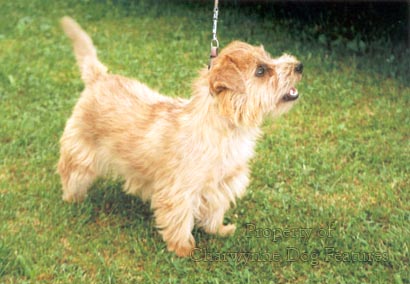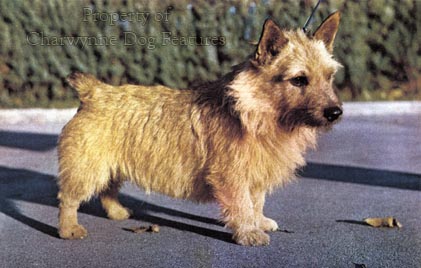618 Breed Differences
BREEDING DIFFERENCES - RESPONSIBLY
by David Hancock
 Norfolk Terrier or Norwich Terrier? Mahogany Sussex Spaniel or chestnut Field Spaniel? Bred differences matter greatly to many. The worry is that in the exhibition of breeds, we concentrate on breed differences and end up exaggerating the coat-length, the shoulder height, the shortness of the muzzle, the length of the ears and the importance of coat colour. All too soon such identified features become components of essential breed type and the function of the breed overlooked. This is never good for a breed. In the past, function always dictated form, to the benefit of the dog; I doubt if show-ring fashion will ever benefit a breed. Every week the dog papers print critiques of judges from dog shows in which the quality of movement is deplored, the shortness of the upper arm decried, the uprightness of the shoulders condemned and the lack of hard condition regretted. This is not good news for purebred dogs.
Norfolk Terrier or Norwich Terrier? Mahogany Sussex Spaniel or chestnut Field Spaniel? Bred differences matter greatly to many. The worry is that in the exhibition of breeds, we concentrate on breed differences and end up exaggerating the coat-length, the shoulder height, the shortness of the muzzle, the length of the ears and the importance of coat colour. All too soon such identified features become components of essential breed type and the function of the breed overlooked. This is never good for a breed. In the past, function always dictated form, to the benefit of the dog; I doubt if show-ring fashion will ever benefit a breed. Every week the dog papers print critiques of judges from dog shows in which the quality of movement is deplored, the shortness of the upper arm decried, the uprightness of the shoulders condemned and the lack of hard condition regretted. This is not good news for purebred dogs. 
I do not know of one breed which still earns its keep in the field and which displays the exaggerations of show ring dogs. The 'Teckels' I watched working in Germany did not feature the elongated backs, abbreviated legs and weak feet of their British show ring counterparts. The snipey muzzles, short backs and upright shoulders of so many show Fox Terriers are not matched in hunt terriers. Springers at trials do not feature the heavy coats favoured in the show ring. Bloodhounds of the packs do not display the ear length and looseness of skin of all too many show Bloodhounds. There should be no confusion here; what does a breed need in order to function? That should be the key question.
In the wake of disasters such as the foot and mouth crisis and in a future which threatens hunting dogs, we could end up one day with sporting and pastoral breeds which lose their functional physique and eventually their breed type too. The show ring already condones exaggerations which are not only alien to a breed but a threat to its well-being. There is a great need for vigilance in some breeds now. In the coming years every breed developed for a purpose will develop differently if that purpose is lost sight of. Showy high-stepping or alternatively, short-stepping dogs, with ears on the ground and untypically heavy coats never featured in the breeds created and passed down to us by our ancestors.
Recognition of a breed should bring uniformity of type, the chance of better-bred dogs and access to shared expertise. But sadly all too often it brings a closed gene pool, closed minds in breeders and quite needless decline. For any kennel club, home or abroad, to see itself as having a role in the improvement of breeds and then sit on its hands and do nothing when breeds are bred unwisely is contradictory. But when was the last time in any country when the national kennel club spoke up on a breed issue out of concern for that breed? It would be good to be informed of such an instance.
At a time when breed-specific anti-dog legislation is being rightly ridiculed and now campaigned against by our Kennel Club, it is important to recall their role when the dreaded DDA of 1991 was being drafted. It was our KC which advised the Home Office on which breeds should be proscribed here. Commendably they have changed their stance. But if they hadn't advised the Home Office as they did thirteen years ago we would not have had breed-specific legislation here at all. And would that not have influenced our European neighbours? Against that background, how can we trust such a body to safeguard the future of our precious breeds? 
It would be unwise and unrealistic however to expect kennel clubs to assume the mantle of breed-protector alone. What are breed clubs for? Most breed clubs would be better named Exhibition Society for that breed, for that seems to preoccupy them. A breed club should have a strong ethical role; the first items on any breed club committee's agenda should be: Breed Health; Breed Rescue; Breed Improvement; three items surely much more challenging, and rewarding, than Judging Appointments; Cups and Trophies and Show Programme. A position with authority means a position with responsibility. But who really is responsible for our precious breeds at the moment?
Unless there is some leadership in saving threatened breeds, guarding true breed type, enhancing breed health and working towards the betterment of the breed, the outlook is gloomy. A combination of eroded breed type, harmful design, poor genetic health and a lack of sound physique is going to undermine a number of breeds; it is never too late to stop and rethink any issue. Surely this one is worthy of our time. British breeds of dog are admired the world over but there is work to be if that wholly desirable situation is to continue.